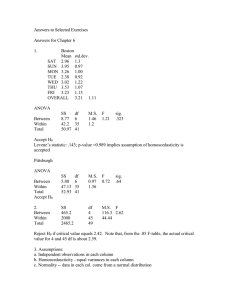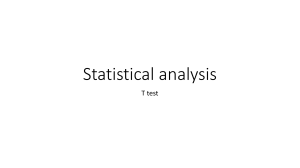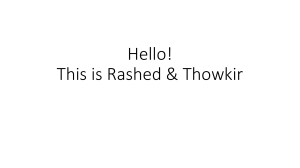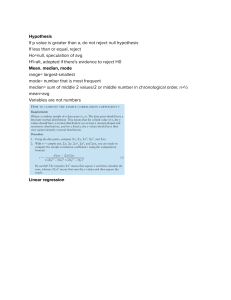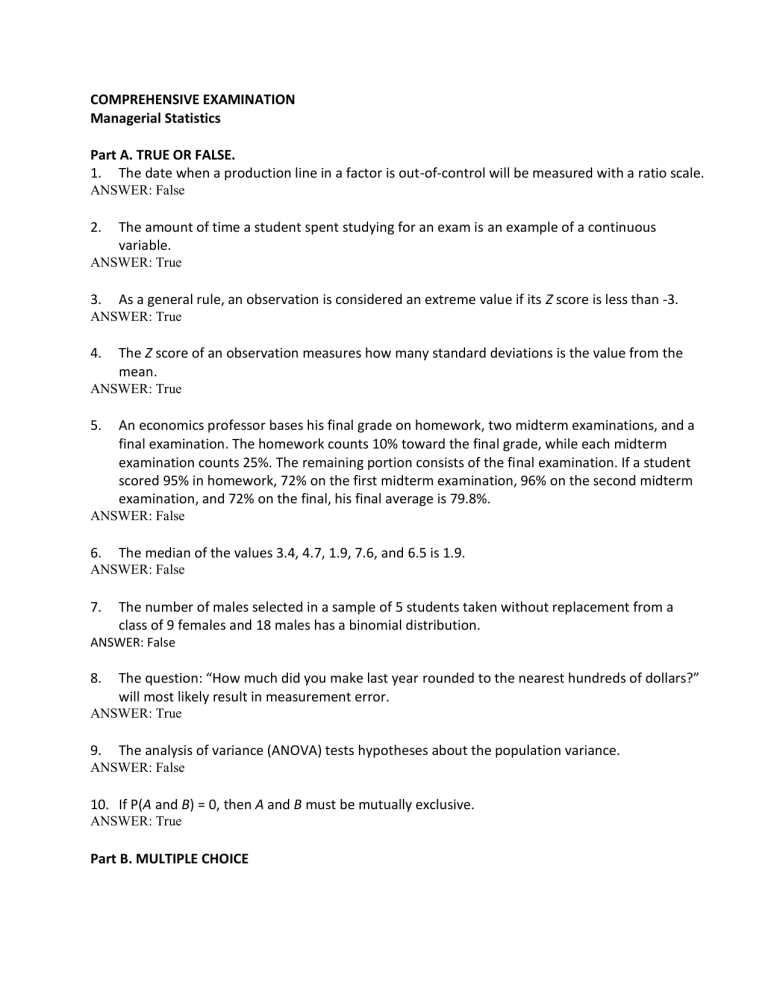
COMPREHENSIVE EXAMINATION Managerial Statistics Part A. TRUE OR FALSE. 1. The date when a production line in a factor is out-of-control will be measured with a ratio scale. ANSWER: False 2. The amount of time a student spent studying for an exam is an example of a continuous variable. ANSWER: True 3. As a general rule, an observation is considered an extreme value if its Z score is less than -3. ANSWER: True 4. The Z score of an observation measures how many standard deviations is the value from the mean. ANSWER: True 5. An economics professor bases his final grade on homework, two midterm examinations, and a final examination. The homework counts 10% toward the final grade, while each midterm examination counts 25%. The remaining portion consists of the final examination. If a student scored 95% in homework, 72% on the first midterm examination, 96% on the second midterm examination, and 72% on the final, his final average is 79.8%. ANSWER: False 6. The median of the values 3.4, 4.7, 1.9, 7.6, and 6.5 is 1.9. ANSWER: False 7. The number of males selected in a sample of 5 students taken without replacement from a class of 9 females and 18 males has a binomial distribution. ANSWER: False 8. The question: “How much did you make last year rounded to the nearest hundreds of dollars?” will most likely result in measurement error. ANSWER: True 9. The analysis of variance (ANOVA) tests hypotheses about the population variance. ANSWER: False 10. If P(A and B) = 0, then A and B must be mutually exclusive. ANSWER: True Part B. MULTIPLE CHOICE 11. The closing price of a company’s stock tomorrow can be lower, higher or the same as today’s closed. Without any prior information that may affect the price of the stock tomorrow, the probability that it will close higher than today’s close is 1/3. This is an example of using which of the following probability approach? a. A priori classical probability b. Empirical classical probability c. Subjective probability d. Conditional probability ANSWER: a 12. Scientists in the Amazon are trying to find a cure for a deadly disease that is attacking the rain forests there. One of the variables that the scientists have been measuring involves the diameter of the trunk of the trees that have been affected by the disease. Scientists have calculated that the average diameter of the diseased trees is 42 centimeters. They also know that approximately 95% of the diameters fall between 32 and 52 centimeters and almost all of the diseased trees have diameters between 27 and 57 centimeters. When modeling the diameters of diseased trees, which distribution should the scientists use? a. Uniform distribution b. Binomial distribution c. Normal distribution d. Exponential distribution ANSWER: c 13. Which of the following sampling methods will more likely be susceptible to ethical violation? a. Simple random sample b. Cluster sample c. Convenience sample d. Stratified sample ANSWER: c 14. The Dean of Students mailed a survey to a total of 400 students. The sample included 100 students randomly selected from each of the freshman, sophomore, junior, and senior classes on campus last term. What sampling method was used? a. Simple random sample b. Systematic sample c. Stratified sample d. Cluster sample ANSWER: c 15. Which of the following types of samples can you use if you want to make valid statistical inferences from a sample to a population? a. A judgment sample b. A quota sample c. A chunk d. A probability sample ANSWER: d 16. In a one-way ANOVA, if the computed F statistic exceeds the critical F value we may a. reject H0 since there is evidence all the means differ. b. reject H0 since there is evidence of a treatment effect. c. not reject H0 since there is no evidence of a difference. d. not reject H0 because a mistake has been made. ANSWER: b 17. Interaction in an experimental design can be tested in a. a completely randomized model. b. a randomized block model. c. a two-factor model. d. all ANOVA models. ANSWER: c 18. If we are testing for the difference between the means of 2 related populations with samples of n1 = 20 and n2 = 20, the number of degrees of freedom is equal to a. 39. b. 38. c. 19. d. 18. ANSWER: c DRUNK DRIVING Mothers Against Drunk Driving is a very visible group whose main focus is to educate the public about the harm caused by drunk drivers. A study was recently done that emphasized the problem we all face with drinking and driving. Four hundred accidents that occurred on a Saturday night were analyzed. Two items noted were the number of vehicles involved and whether alcohol played a role in the accident. The numbers are shown below: Did alcohol play a role? Yes No Totals Number of Vehicles Involved 1 2 3 50 25 75 100 175 275 20 30 50 19. What proportion of accidents involved alcohol or a single vehicle? a. 25/400 or 6.25% b. 50/400 or 12.5% c. 195/400 or 48.75% Totals 170 230 400 d. 245/400 or 61.25% ANSWER: c 20. Referring to Table 4-1, given that multiple vehicles were involved, what proportion of accidents involved alcohol? a. 120/170 or 70.59% b. 120/230 or 52.17% c. 120/325 or 36.92% d. 120/400 or 30% ANSWER: c Part C. FILL IN THE BLANKS The table below contains the opinions of a sample of 200 people broken down by gender about the latest congressional plan to eliminate anti-trust exemptions for professional baseball. Female Male Totals For 38 12 50 Neutral 54 36 90 Against 12 48 60 Totals 104 96 200 21. Out of the males in the sample, ________ percent were for the plan. ANSWER: 12.50% 22. ________ percent of the 200 were females who were against the plan. ANSWER: 6% 23. _______ percent of the 200 were males who were not against the plan. ANSWER: 24% 24. if the sample is a good representation of the population, we can expect _______ percent of the population will be for the plan. ANSWER: 25% 25. Suppose that patrons of a restaurant were asked whether they preferred beer or whether they preferred wine. 70% said that they preferred beer. 60% of the patrons were male. 80% of the males preferred beer. The probability a randomly selected patron prefers wine is __________. ANSWER: 0.30 26. The amount of time necessary for assembly line workers to complete a product is a normal random variable with a mean of 15 minutes and a standard deviation of 2 minutes. So, 70% of the products would be assembled within __________ minutes. ANSWER: 16.0488 using Excel or 16.04 using Table E.2 27. Suppose Z has a standard normal distribution with a mean of 0 and standard deviation of 1. So 96% of the possible Z values are between __________ and __________ (symmetrically distributed about the mean). ANSWER: -2.05 and 2.05 or -2.06 and 2.06 28. The true length of boards cut at a mill with a listed length of 10 feet is normally distributed with a mean of 123 inches and a standard deviation of 1 inch. What proportion of the boards will be less than 124 inches? ANSWER: 0.8413 29. If you were constructing a 99% confidence interval of the population mean based on a sample of n=25 where the standard deviation of the sample s = 0.05, the critical value of t will be______ ANSWER: 2.7969 30. In the construction of confidence intervals, if all other quantities are unchanged, an increase in the sample size will lead to a interval. ANSWER: narrower HOME IMPROVEMENT STORE A major home improvement store conducted its biggest brand recognition campaign in the company’s history. A series of new social media advertisements featuring well-known entertainers and sports figures were launched. A key metric for the success of advertisements is the proportion of viewers who “like the ads a lot”. A study of 1,189 adults who viewed the ads reported that 230 indicated that they “like the ads a lot.” The percentage of a typical advertisement receiving the “like the ads a lot” score is believed to be 22%. Company officials wanted to know if there is evidence that the series of advertisements are less successful than the typical ad (i.e. if there is evidence that the population proportion of “like the ads a lot” for the company’s ads is less than 0.22) at a 0.01 level of significance. 31. The parameter the company officials is interested in is ___________________. ANSWER: the proportion of viewers who “like the ads a lot” 32. State the null hypothesis for this study. ANSWER: H 0 : p 0.22 33. State the alternative hypothesis for this study. ANSWER: H1 : p 0.22 34. What critical value should the company officials use to determine the rejection region? ANSWER: 2.3263 35. The null hypothesis will be rejected if the test statistics is _______________. ANSWER: less than 2.3263 36. State the decision for this problem. ANSWER: Do not reject the null hypothesis. 37. State the conclusion for this problem. ANSWER: The company officials can conclude that there is sufficient evidence to show that the series of television advertisements are less successful than the typical ad using a level of significance of 0.05. Part D. ANALYSIS and INTERPRETATION Aria’s Bakeshop supplies pastry products to a number of supermarkets in the city and wishes to study the effect of the shelf display height on monthly sales measured in number of cases. Shelf display height has three levels – Bottom, Middle and Top, set as treatments. For each shelf height, 6 supermarket, the experimental units, displays the products using its assigned shelf height for a month. At the end of the month, sales, the response variable, at the 18 participating stores are recorded as: Bottom 58.2 53.7 55.8 55.7 52.5 58.9 Middle 73.0 78.1 75.4 76.2 78.4 82.1 Top 52.4 49.7 50.9 54.0 52.1 49.9 Assume that the amount of sales for each display height is randomly selected from the population of all sales amounts that could be obtained at supermarkets at that display height. Shown is the Excel result of the test conducted: Anova: Single Factor SUMMARY Groups Bottom Middle Top Count 6 6 6 ANOVA Source of Variation Between Groups Within Groups SS 2273.88 92.4 Total 2366.28 38. What is the null hypothesis? Sum Average Variance 334.8 55.8 6.136 463.2 77.2 9.628 309 51.5 2.716 df 2 15 17 MS F P-value 1136.94 184.5682 2.74E-11 6.16 F crit 3.68232 ANSWER: Ho: µ1 = µ2 39. What is the total variation equal to? ANSWER: 2366.28 40. What is the decision about the null hypothesis? ANSWER: Reject the null hypothesis 41. Interpret the indication of the computed p-value. ANSWER: The test failed to accept the null hypothesis since there is a significant difference between means of bottom, middle and top shelves at alpha = 0.05. 42. State the conclusion of the study conducted by Aria’s Bakeshop. ANSWER: The sales are significantly different for different shelf height levels. Therefore, the shelf height levels affect the sales of Aria’s Bakeshop products. Refer to MRA Result A shown below to answer the following questions: 43. What is the part of the variation in Selling Price that can be explained by the regression equation? ANSWER: 6635.481 44. What is the part of the variation in Selling Price that is not explained by the regression equation? ANSWER: 1018.239 45. What is the total variation equal to? 7653.730 46. What is the proportion of the variability in Selling Price that can be explained by the regression equation? ANSWER: 86.7% of the variation in selling price can be explained by the variation due to the number of rooms and the neighborhood. 47. What is the proportion of the variability in Selling Price that are due to other factors? ANSWER: 13.3% of the variation in Selling price is due to factors other than number of rooms and neighborhood. 48. What is the variation around the prediction line? ANSWER: 7.739 49. What is the regression equation? ANSWER: Selling Price = 243.7371 + 9.2189 * (the number of rooms) + 12.6367 * (the type of neighborhood) 50. Predict the price of a house with 9 rooms and located in the west side neighborhood. Make sure to include the units in your answer. ANSWER: Selling Price = 243.7371 + (9.2189 * 9) + (12.6367 * 1) = 339.3439 * 1000 = $ 339,343.90


